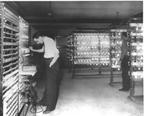The Industrial Age: Overview
In the early years of the 20th century, electricity became the power behind American industry. Electric utilities, appliance manufacturers, and communications companies proliferated. This was also the era of industrial development; Henry Ford organized the first U.S. assembly line in 1913.

Most of the values for electrical units available to science and industry were imprecise and tentative, so NIST performed electrical research and testing. Thanks in part to this work, absolute electrical measurements became more accurate than was generally believed possible. The Institute helped improve the accuracy of the values established for the primary electrical units, thereby helping industry make better products and supporting international redefinitions of the ampere, ohm, and volt. NIST also studied underground corrosion of gas mains and water pipes caused by the electric current flowing to city trolleys and came up with almost 20 methods of mitigating this costly national problem.
NIST set to work saving money for the federal government, which bought 1 million incandescent lamps per year and found them quickly burning out. Tests on the lamps showed they did not conform to either the manufacturer's standards or federal specifications. Similar problems were found with a whole catalog of supplies. The Institute tested everything from an elevator cable for the Washington Monument to inks for the Government Printing Office.
NIST also performed materials research. In the early years of the century, thousands of train derailments were caused by broken rails, broken wheels, flanges, and axles. From 1912 to 1923, NIST subjected failed parts to chemical, microscopic, and mechanical tests and investigated railroad iron and steel constituents and manufacturing. The Institute reported that the steel industry had not established uniform practices in the manufacture of rails and wheels. By 1930, as better steel went into rails and trains-with NIST's help in standardizing materials and processing-the rate of accidents from these causes fell by two-thirds.
Because the analysis of materials could not be separated from their synthesis, NIST began to acquire experimental factories to study the effects of manufacturing conditions on product quality. These factories became especially useful when World War I began in Europe in 1914. NIST was asked to help address many military needs, from experiments with concrete ships to the testing of various metals to the making of high-precision gage blocks needed to manufacture interchangeable parts. In some projects, the Institute introduced new fundamental principles and concepts of quantitative measurements to industry. By late 1917, shortly before the war ended in 1918, the military services were requesting some sort of scientific work from the Institute every 20 minutes.
Among its accomplishments, NIST helped modernize U.S. aviation. In the decade after the Wright brothers' first flight in 1903, U.S. military forces had only several dozen aircraft, all obsolete by European standards. All sorts of aviation instruments were sent to the Institute for testing, and many were modified or overhauled entirely before being adopted by the military. Institute studies yielded the first quantitative data reported anywhere on the power- producing qualities of fuels. The first serious U.S. studies of the aerodynamics of flight were performed by NIST, which built a wind tunnel with a 2.7 meter (9 foot) propeller that was used to study wind stresses, airspeed indicators, and other instruments.
Both before and after the war, NIST carried out considerable basic research, much of it involving the determination and refinement of physical constants-quantities believed to be the same for all observers and for all time. Some of these were important in science, including standards development, whereas others were needed by industry (the refrigeration industry, for example, needed to know the specific heat of ice) to improve products and processes. By the end of the war, it was clear that scientific methods could contribute to industrial technology, and that fundamental science could have far-reaching consequences at some later time. Industries expanded their scientific staffs; one legacy of World War I was new fields of industrial research.
In its first two decades, NIST won an international reputation for its achievements in physical measurements, standards development, and test methods. Through its standards of measurement, instrumentation, and performance it sought to raise the scientific level of industry. The techniques of mass production introduced during the war gave an enormous impetus to the standardization of methods and materials.
| Notice of Online Archive: This page is no longer being updated and remains online for informational and historical purposes only. The information is accurate as of 2001. For questions about page contents, please inquiries [at] nist.gov (contact us). |

